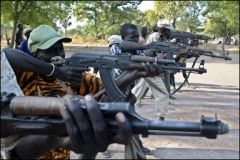FACTBOX-Military aspect of the Sudanese peace agreement
NAIROBI, Jan 21, 2005 (TTU) — The signature in Nairobi on 9 January of the peace agreement between the Sudanese government and the SPLA (Sudanese People’s Liberation Army), gave the green light for the enforcement of the permanent cease-fire agreement between the two parties.

|
|
Soldiers of the Sudan People’s Liberation Army train in the southern Sudanese town of Rumbek. (AFP). |
The agreement consists of four majors steps.
The first one, which starts at the time of signature, lasts six months, the second one covers the first half of the interim period, i.e. 36 months, while the third period covers the second half. The last one starts at the end of this six-year term.
The two parties have agreed to monitor and enforce the cease-fire agreement through various bodies: the cease-fire political commission (CPC), cease-fire joint military commission (CJMC), areas joint military commission (AJMC) and joint military teams (JMT) made
up of 5 to 6 soldiers from both sides.
According to the signed agreement, the border separating the north from the south (as defined on 1 January 1956) constitutes the deployment line of the forces.
During the first two years, government forces will have to reduce their military presence in the southern part of the country and every six months the strength of the forces
will be decreased, by 17, 14, 19 and 22 per cent accordingly. In return, the SPLM (Sudanese People’s Liberation Movement, the political branch of the
SPLA) will have to decrease its force deployed in the eastern part of Sudan by 30 per cent during the four months following the signature of the agreement, and then by 40 per cent over the following four months. All forces will have to be completely withdrawn from the east at the end of a 12-month period.
One of the toughest points of negotiation was the question
of the SPLA¹s financing, which the Sudanese government refused to include in the State budget. The compromise provides that the JIU (Joint Integrated Unit) — the base of the Sudanese army under a unified command — will be
financed by the budget while the southern government will finance its own troops.
The agreement also provides that the other militias will be
integrated into either the SPLM or government troops within the next six months.
Finally the two sides have decided to reorganise the security and intelligence service, which will integrate SPLA officers (representing 25 per cent of the services strength). President Omar Bachir just enacted a law
on 12 January and dismissed six senior officers in the security and intelligence service, to be replaced by SPLM’s officers.
